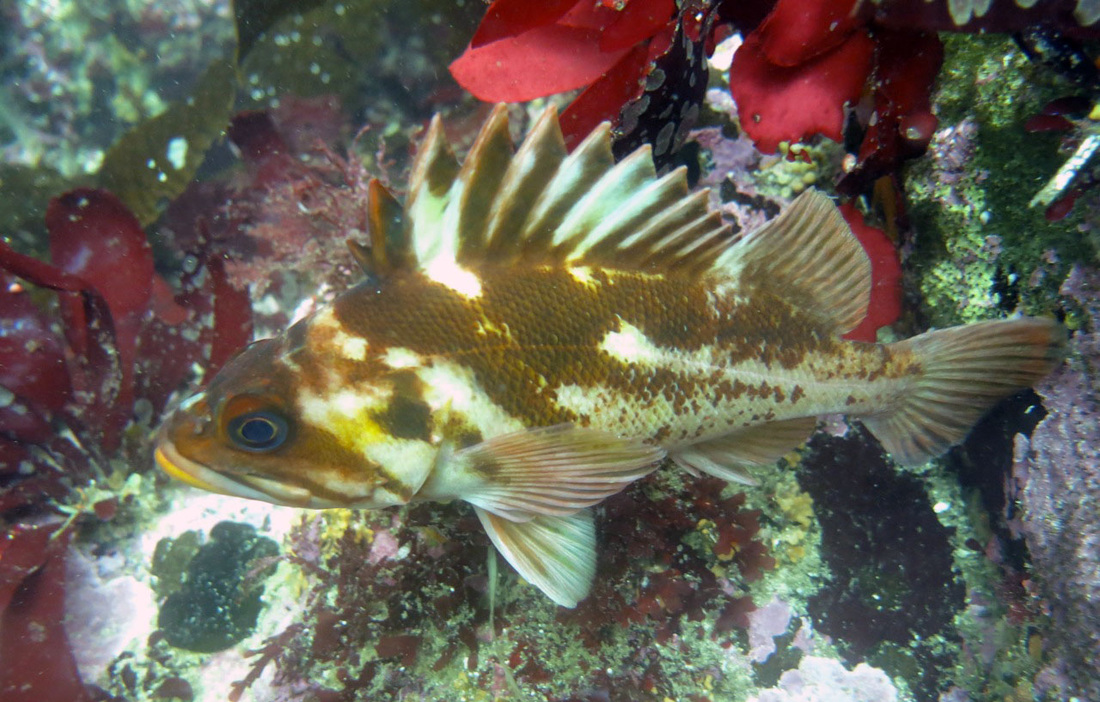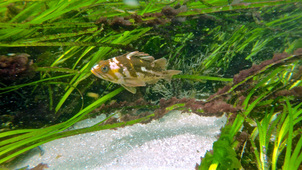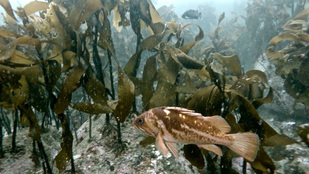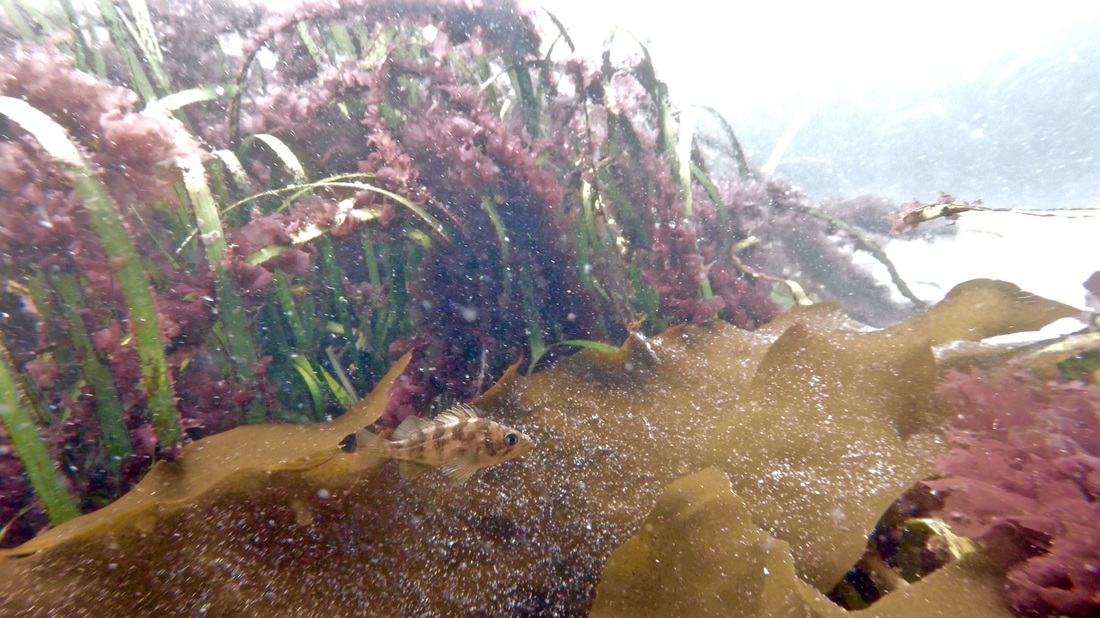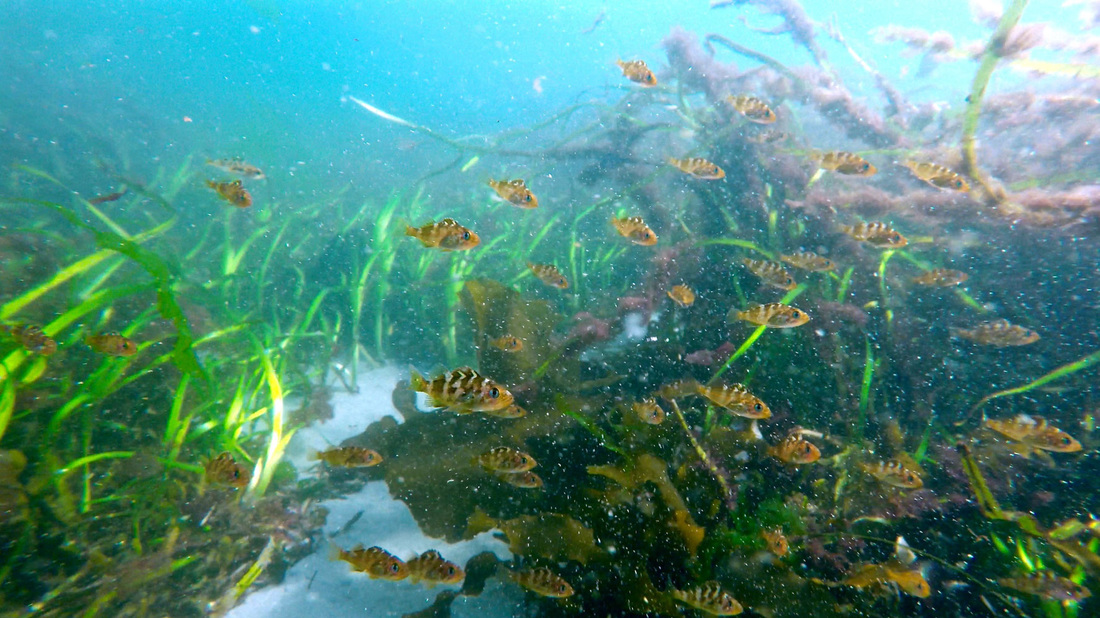Copper rockfish, yellow-backed rockfish • Sebastes caurinus • Heiltsuk/Haíɫzaqv - λák̓álá
{Sebastos = magnificent, venerable; caurinus = northwest}
Copper rockfish photographed by Jenn Burt (top left) and Tristan Blaine. Bottom right shows a school of juveniles (young of the year) identified as CQBs (Copper-Quillback-Brown rockfish complex), as these three species appear similar as young of the year juveniles and cannot be differentiated visually.
Identification
The copper rockfish is copper to olive brown in colour and tinged with yellow and pink blotches. It has white on its belly, sides, and along the posterior two-thirds of its lateral line (raised line along the side of the body). Dark bands run down from its eyes parallel to its mouth. The copper rockfish is usually no more than 40 cm long, though it can get up to 66 cm long and 4.5 kg.
Habitat & Range
Adults inhabit rocky reefs, where they spend most of their time foraging near the bottom. They are most abundant in protected inshore shallow waters. Juveniles may be found closer to the surface and in tidepools. Both adults and juveniles may be seen around wharves. This often common species is found from the intertidal to depths of 180 m or more. Its range extends from central Alaska to northern Mexico.
Human Uses
Like other rockfish, copper rockfish is mislabeled as red snapper, Pacific snapper, and rockcod in both markets and restaurants. It is flaky and full of flavour, and is often used in fish and chips and pan-fried fillets. Copper rockfish can be abundant in some areas, though its abundance is diminishing due to heavy exploitation since the 1980s. Some areas have seen large population depletions due to a commercial fishery for sale in live-fish markets, and to increasing pressure from recreation anglers as populations other target species such as Pacific salmon diminish. Copper rockfish is listed as "Avoid" by the Monterey Bay Seafood Watch and "Not Recommended" by Ocean Wise.
Concerns about rockfish population levels have led to the creation of Rockfish Conservation Areas (RCAs) in inshore locations along the BC coast. See the Living Oceans Society map of RCAs and Fisheries and Oceans Canada for more information on these areas.
Intriguing Info
Rockfish can live for many decades. The oldest recorded copper rockfish was 57 years old.
iNaturalist
https://www.inaturalist.org/taxa/68597-Sebastes-caurinus
The copper rockfish is copper to olive brown in colour and tinged with yellow and pink blotches. It has white on its belly, sides, and along the posterior two-thirds of its lateral line (raised line along the side of the body). Dark bands run down from its eyes parallel to its mouth. The copper rockfish is usually no more than 40 cm long, though it can get up to 66 cm long and 4.5 kg.
Habitat & Range
Adults inhabit rocky reefs, where they spend most of their time foraging near the bottom. They are most abundant in protected inshore shallow waters. Juveniles may be found closer to the surface and in tidepools. Both adults and juveniles may be seen around wharves. This often common species is found from the intertidal to depths of 180 m or more. Its range extends from central Alaska to northern Mexico.
Human Uses
Like other rockfish, copper rockfish is mislabeled as red snapper, Pacific snapper, and rockcod in both markets and restaurants. It is flaky and full of flavour, and is often used in fish and chips and pan-fried fillets. Copper rockfish can be abundant in some areas, though its abundance is diminishing due to heavy exploitation since the 1980s. Some areas have seen large population depletions due to a commercial fishery for sale in live-fish markets, and to increasing pressure from recreation anglers as populations other target species such as Pacific salmon diminish. Copper rockfish is listed as "Avoid" by the Monterey Bay Seafood Watch and "Not Recommended" by Ocean Wise.
Concerns about rockfish population levels have led to the creation of Rockfish Conservation Areas (RCAs) in inshore locations along the BC coast. See the Living Oceans Society map of RCAs and Fisheries and Oceans Canada for more information on these areas.
Intriguing Info
Rockfish can live for many decades. The oldest recorded copper rockfish was 57 years old.
iNaturalist
https://www.inaturalist.org/taxa/68597-Sebastes-caurinus
References
Froese, R. and Luna, S. M. Sebastes caurinus Richardson, 1844 Copper rockfish. FishBase. Accessed 24/02/2015.
Harbo, R. M. (2011). Whelks to whales: Coastal marine life of the Pacific Northwest [revised]. Madeira Park, BC: Harbour Publishing. P. 217.
Lamb, A. and Edgell, P. Coastal Fishes of the Pacific Northwest. Revised. (2010). Madeira Park, BC: Harbour Publishing. Pp. 148-149.
Lamb, A., and Hanby, B. (2005). Marine Life of the Pacific Northwest [electronic version]. Madeira Park, BC: Harbour Publishing.
Authors and editors of page
Kelly Fretwell and Brian Starzomski (2015).
Froese, R. and Luna, S. M. Sebastes caurinus Richardson, 1844 Copper rockfish. FishBase. Accessed 24/02/2015.
Harbo, R. M. (2011). Whelks to whales: Coastal marine life of the Pacific Northwest [revised]. Madeira Park, BC: Harbour Publishing. P. 217.
Lamb, A. and Edgell, P. Coastal Fishes of the Pacific Northwest. Revised. (2010). Madeira Park, BC: Harbour Publishing. Pp. 148-149.
Lamb, A., and Hanby, B. (2005). Marine Life of the Pacific Northwest [electronic version]. Madeira Park, BC: Harbour Publishing.
Authors and editors of page
Kelly Fretwell and Brian Starzomski (2015).
